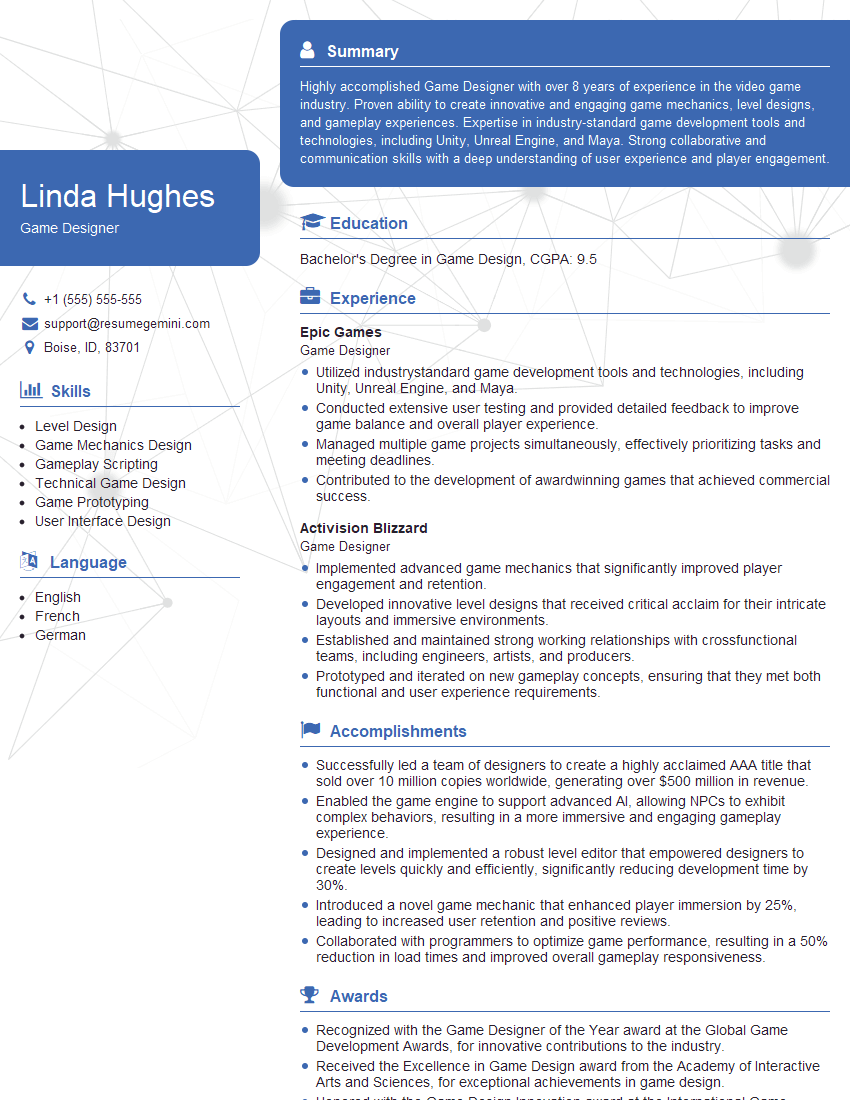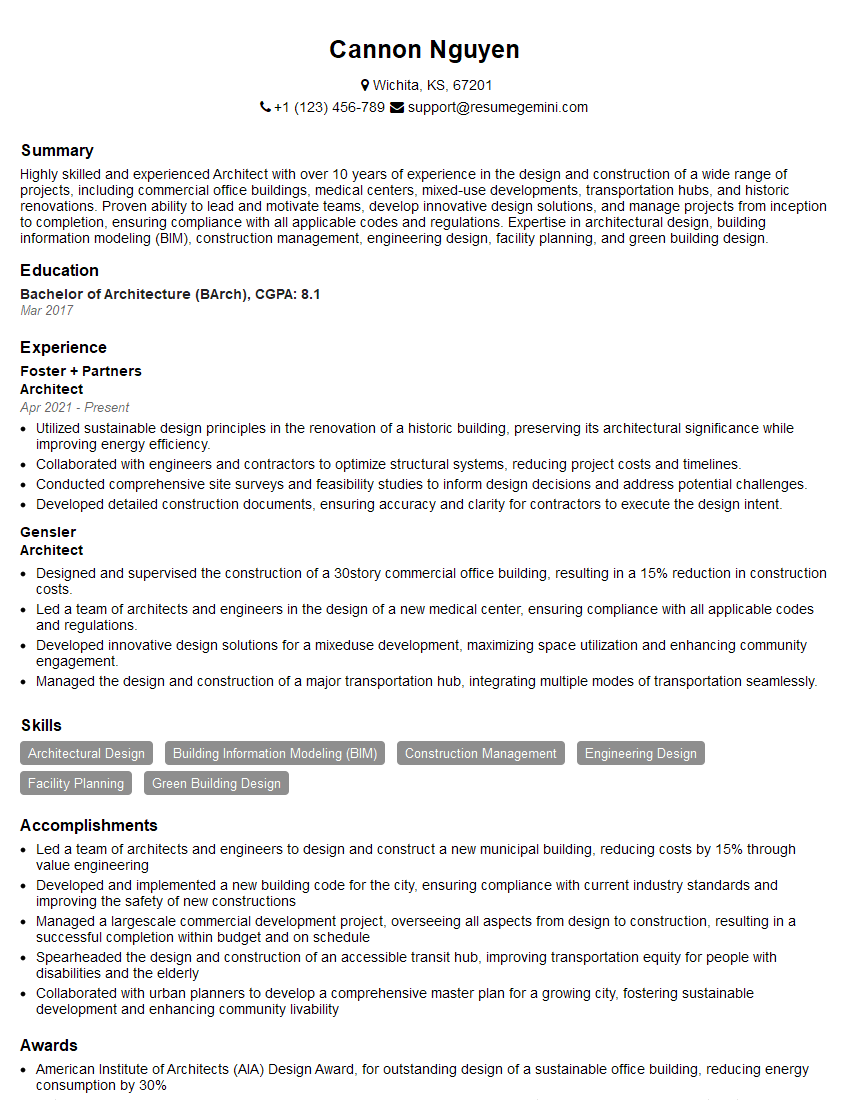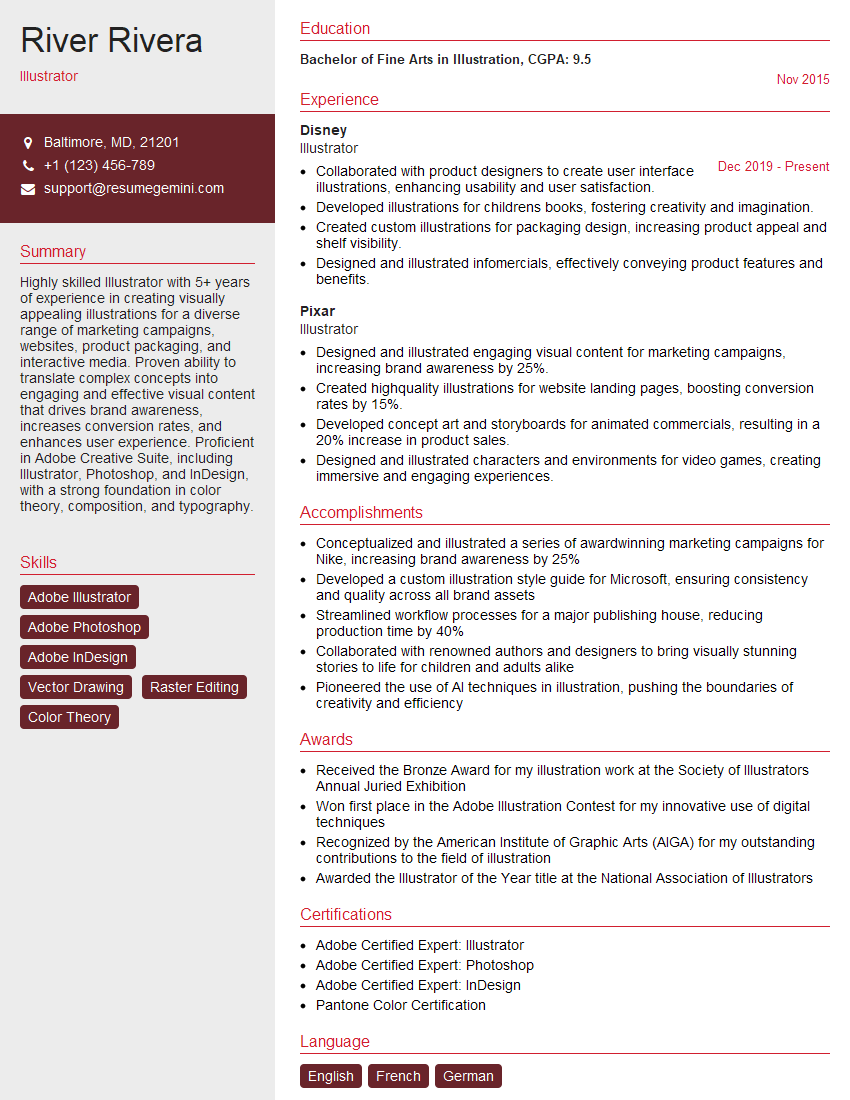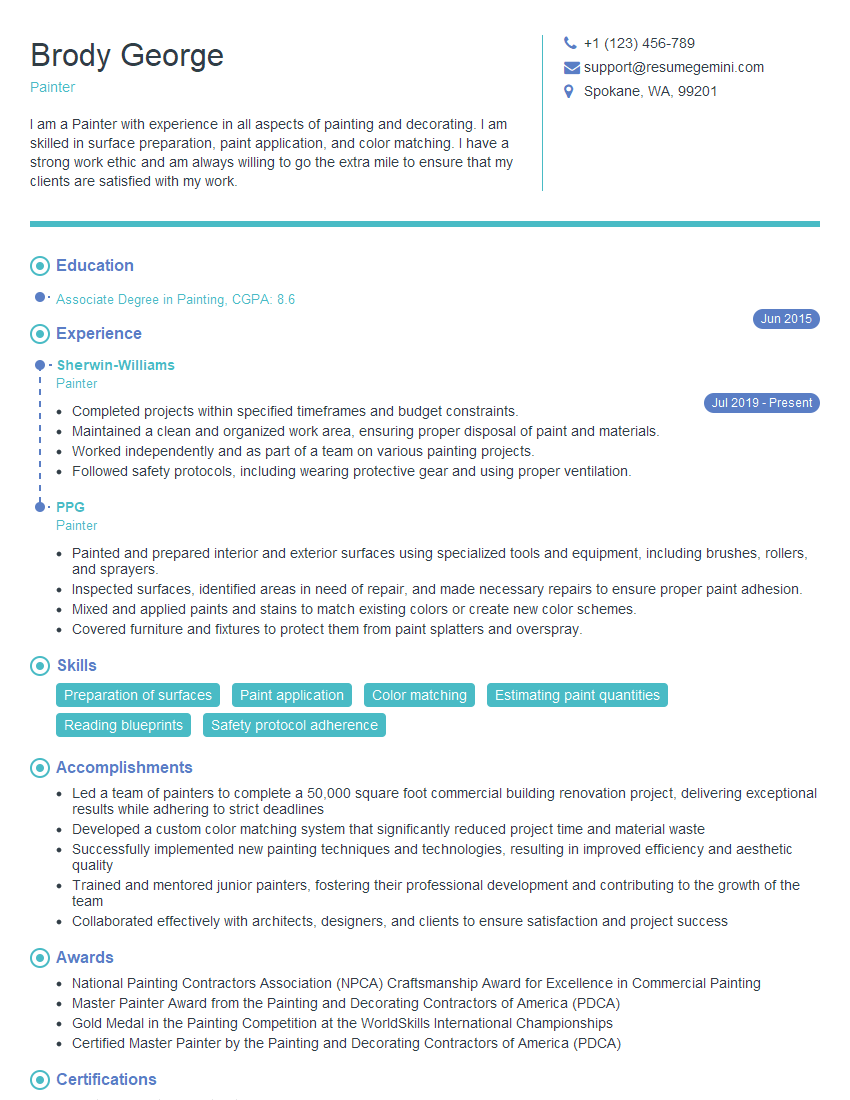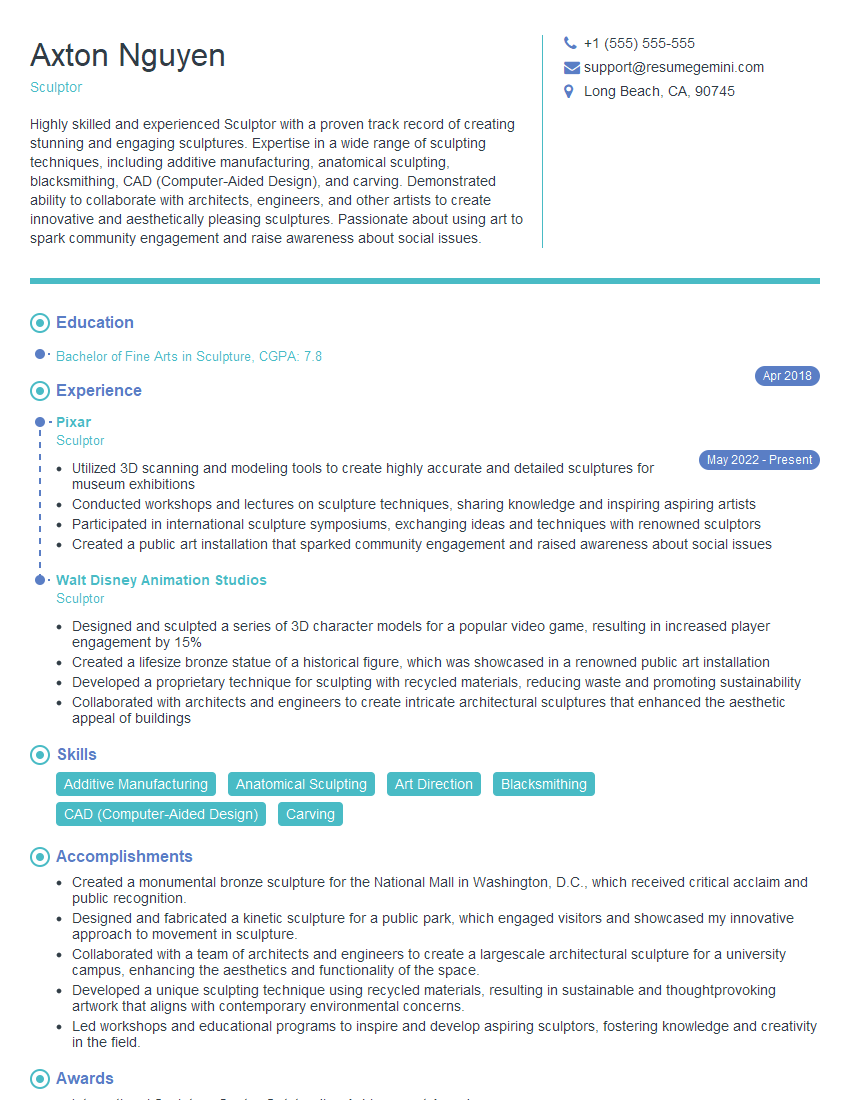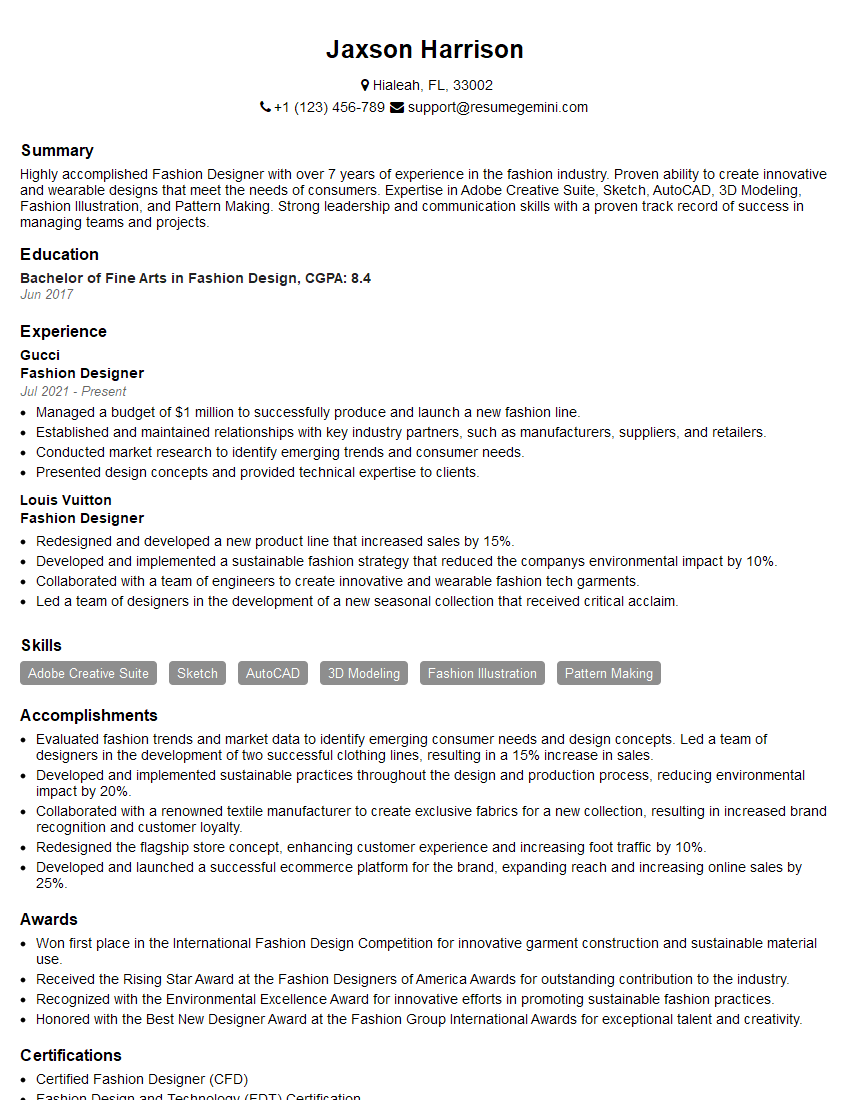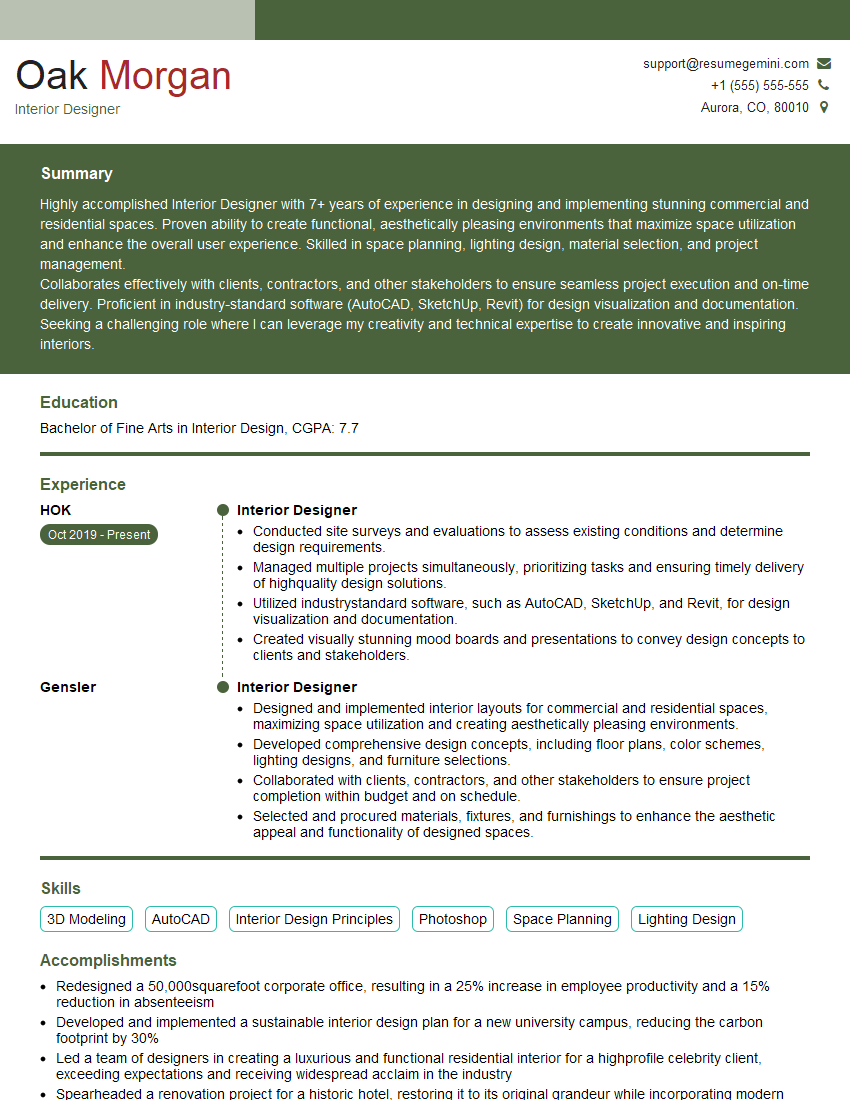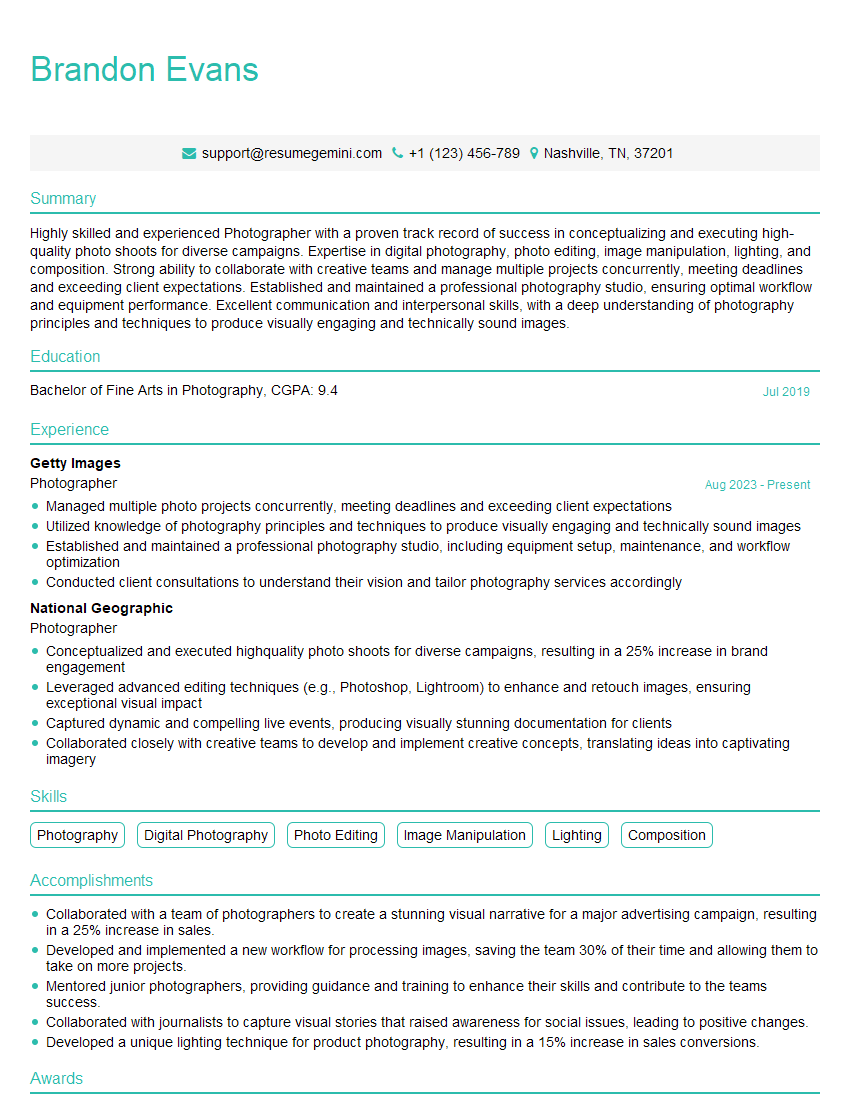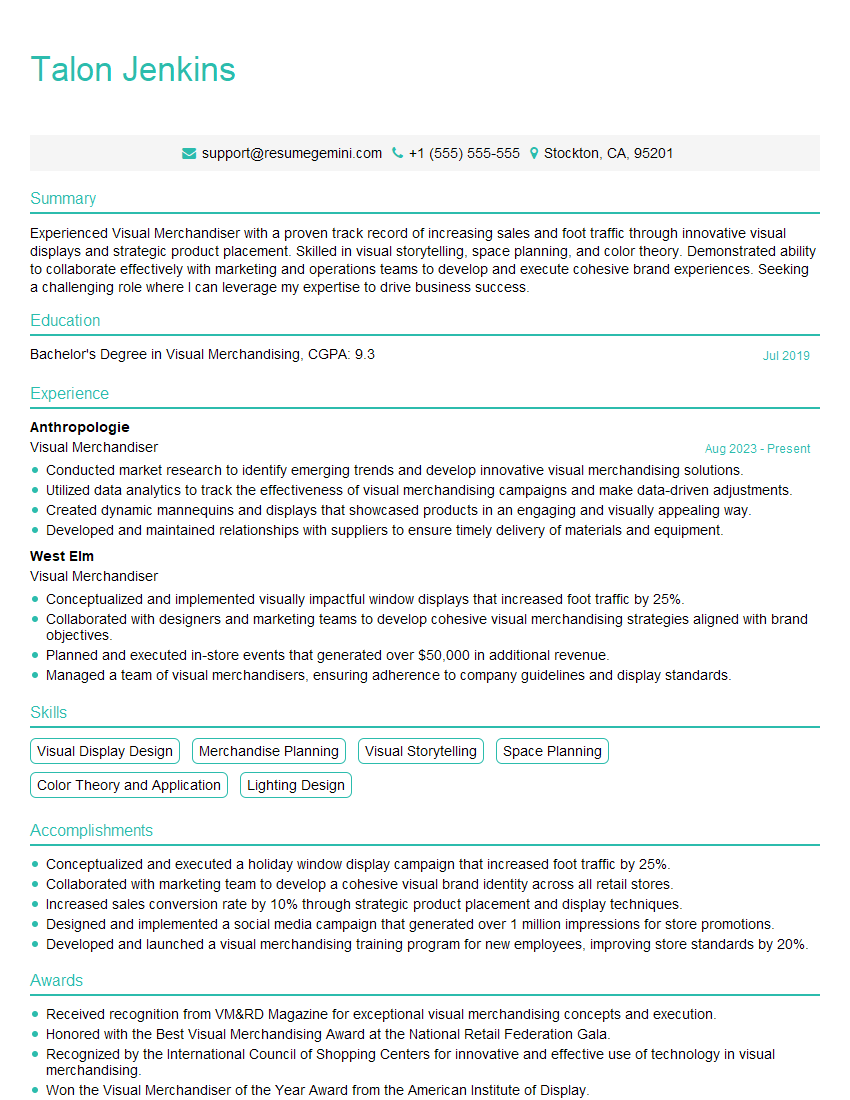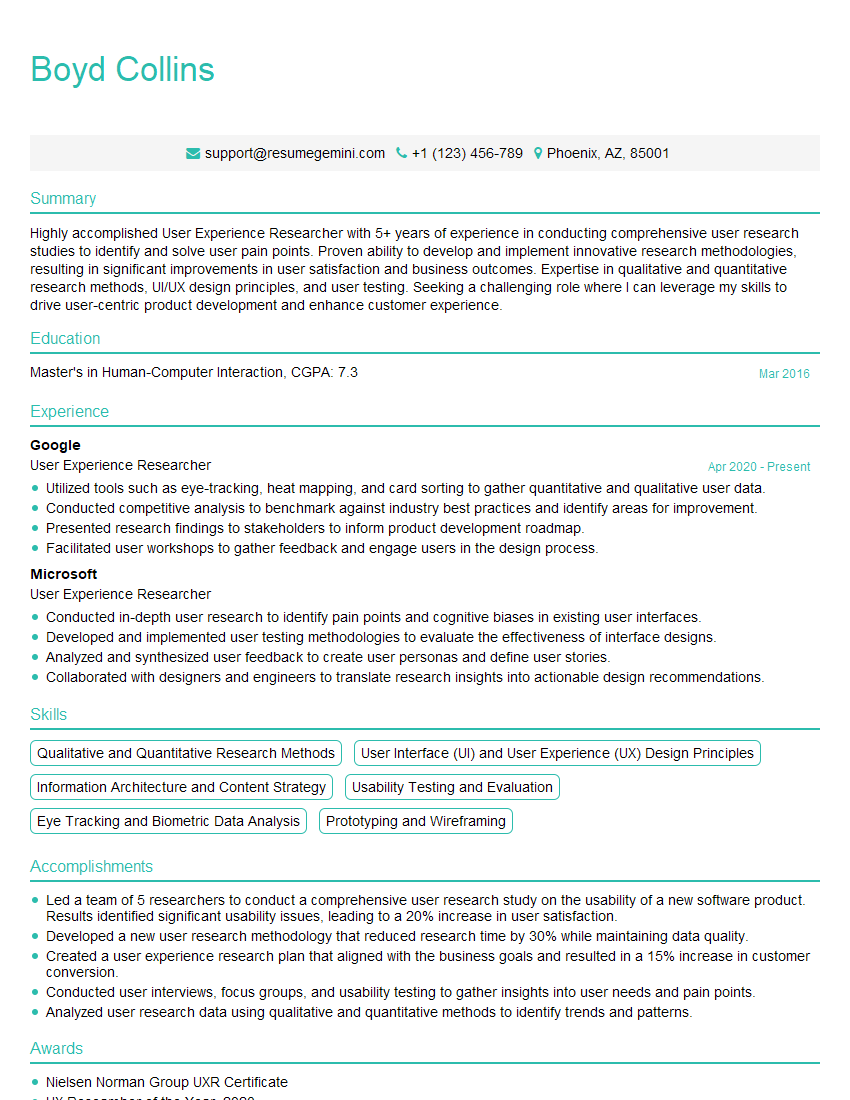Unlock your full potential by mastering the most common Artistic sensitivity and creative expression interview questions. This blog offers a deep dive into the critical topics, ensuring you’re not only prepared to answer but to excel. With these insights, you’ll approach your interview with clarity and confidence.
Questions Asked in Artistic sensitivity and creative expression Interview
Q 1. Describe your creative process when approaching a new project.
My creative process is iterative and deeply personal, but it generally follows a few key stages. It begins with immersion: I thoroughly research the project’s context, objectives, and target audience. This might involve studying relevant art history, conducting interviews, or simply spending time reflecting on the project’s core theme. Next comes ideation, where I brainstorm ideas, sketch freely, and experiment with different approaches. I find mind-mapping and mood boards invaluable during this phase. This leads to development, where I refine my best ideas, creating prototypes or detailed sketches. Crucially, this involves continuous evaluation; I constantly assess whether the work aligns with the initial vision and adjust accordingly. Finally, there’s refinement and completion, where I focus on the finer details, ensuring technical proficiency and overall artistic cohesion.
For example, when designing a mural for a community center, I would first visit the center, interview residents to understand their needs and aspirations, and research local art styles. Then, I would sketch various concepts, exploring different color palettes and visual narratives before settling on a final design.
Q 2. How do you incorporate feedback into your creative work?
Feedback is integral to my creative process. I actively solicit it from diverse sources, including colleagues, clients, and even test audiences. I view feedback not as criticism, but as valuable insights that can enhance the work. My approach involves actively listening, asking clarifying questions to fully understand the feedback’s context, and then thoughtfully considering how to integrate it. Not all feedback is equally relevant, so I prioritize feedback that aligns with the project’s goals and enhances its artistic merit. I might not always implement every suggestion, but I always engage with it thoughtfully, documenting the rationale behind my choices.
For instance, if a client suggests a color change that compromises the overall aesthetic, I would explain my artistic rationale and propose alternative solutions that address their concerns while maintaining artistic integrity.
Q 3. Explain how you maintain originality while meeting client briefs.
Balancing originality with client briefs requires a delicate approach. The key is to find creative solutions within the constraints of the brief. I start by deeply understanding the client’s needs and expectations, but I also actively search for opportunities to inject my unique artistic voice. This might involve exploring unconventional techniques, incorporating personal symbolism, or subtly reinterpreting the brief’s core elements. The goal is not to blindly adhere to the brief, but to collaborate creatively with the client to produce something both innovative and effective. Open communication is crucial; I engage the client in a dialogue to explore different artistic interpretations while ensuring the final product meets their requirements.
Imagine a logo design brief requiring a corporate feel. While adhering to corporate design standards, I could explore unique typography, unconventional color combinations, or subtle symbolic elements to infuse originality into the design, making it stand out even within the prescribed framework.
Q 4. How do you handle creative differences with colleagues?
Creative differences are inevitable in collaborative projects. My approach focuses on respectful communication and collaborative problem-solving. I encourage open dialogue where everyone feels comfortable expressing their ideas and perspectives. I believe in active listening, aiming to understand the reasoning behind differing viewpoints. We try to find common ground by identifying shared goals and exploring alternative solutions that incorporate elements from various perspectives. If consensus isn’t immediately achievable, we might use techniques like voting or prototyping to objectively evaluate different options. The goal is always to reach a solution that reflects the best interests of the project and respects the contributions of each team member.
For example, if a colleague prefers a minimalist approach while I envision a more complex design, we might explore creating multiple versions, presenting them to the client, or finding a compromise that incorporates elements from both styles.
Q 5. Describe a time you had to overcome a creative block.
Creative blocks are a common challenge. When I encounter one, I usually begin by stepping away from the project temporarily. I might engage in unrelated activities, like listening to music, going for a walk in nature, or exploring a different medium. This helps to clear my mind and approach the project with fresh perspective. I also find brainstorming with colleagues or revisiting the project’s initial inspiration helpful. Sometimes, simply breaking down the project into smaller, more manageable tasks can overcome the feeling of being overwhelmed. Finally, I believe in embracing experimentation. Trying new techniques or materials can often spark new ideas and help break through the block.
One time, I was struggling with a sculpture. After a few days of frustration, I went for a long walk in the woods. The natural forms and textures inspired me, and I returned to my studio with new ideas, eventually completing a piece that incorporated those natural elements.
Q 6. How do you define ‘artistic sensitivity’ in your work?
In my work, artistic sensitivity encompasses a deep awareness of the emotional and psychological impact of art. It’s about creating work that resonates with the audience on a deeper level, evoking emotions, telling stories, and conveying meaning beyond the purely visual. This involves understanding the nuances of color, composition, texture, and symbolism, and using them effectively to create a desired emotional response. It also involves considering the cultural and historical context of the artwork, recognizing how these elements can inform and shape its meaning and reception. Artistic sensitivity isn’t just about technical skill; it’s about empathy, intuition, and the ability to communicate complex ideas and feelings through creative expression.
For instance, a portrait wouldn’t just be a likeness but would capture the subject’s personality, inner life, and emotional state through subtle choices in lighting, expression, and pose.
Q 7. How do you ensure your work is both aesthetically pleasing and functionally effective?
Balancing aesthetics and functionality is paramount in many creative projects. It’s not a question of choosing one over the other, but of finding a harmonious integration. I believe that true artistry lies in the ability to make something both beautiful and useful. This requires careful consideration of the intended use and the audience’s needs. For example, in web design, the website must be visually appealing but also easy to navigate and user-friendly. In product design, an object’s form should be aesthetically pleasing, but its functionality should not be compromised. This means iteratively testing and refining the design to ensure both criteria are met. Effective communication with clients or users is crucial to understand their functional requirements, which allows for the artistic vision to be expressed in a way that genuinely serves the purpose.
A good example is the design of a piece of furniture; it must be comfortable and functional, but also aesthetically pleasing, contributing to the overall design of a room. The design process would involve considering ergonomics and material choices to ensure both aesthetic appeal and practical usability.
Q 8. Discuss your experience with different creative software or tools.
My creative journey has involved a diverse range of software and tools, each contributing uniquely to my artistic expression. I’m proficient in industry-standard applications like Adobe Photoshop, Illustrator, and InDesign for image manipulation, vector graphics, and layout design respectively. These tools are crucial for print and digital media creation. Beyond these, I’ve explored 3D modeling software such as Blender, which allows for creating and manipulating three-dimensional objects, expanding the possibilities of my creative output. For motion graphics and animation, I utilize After Effects, adding another layer of dynamic expression to my work. Finally, I’m comfortable using various prototyping tools like Figma and Adobe XD for interactive design projects, ensuring a seamless transition from concept to fully functional designs.
For example, when creating a complex illustration incorporating both photographic elements and stylized vector art, I might begin in Photoshop for image editing, then transition to Illustrator for refining vector elements, finally combining them within InDesign for the final layout and print preparation.
Q 9. Explain your understanding of color theory and its application.
Color theory is the foundational principle guiding my artistic choices. It’s the understanding of how colors interact, their psychological impact, and how they can be used to create specific moods and effects. This involves understanding the color wheel – primary, secondary, and tertiary colors – and the relationships between them, including complementary, analogous, and triadic color schemes. I consider factors like hue, saturation, and value (brightness) when selecting and combining colors. Understanding the temperature of colors (warm vs. cool) is also critical, as it significantly influences the overall feeling of a piece.
For instance, using warm colors like reds and oranges often evokes feelings of energy and excitement, while cool colors like blues and greens can convey calmness and serenity. Consider a children’s book illustration: bright, saturated colors would engage young audiences, while a more muted palette might be suitable for a serious graphic novel. My application of color theory always depends on the specific message or emotion I aim to convey.
Q 10. How do you use visual language to convey specific emotions or messages?
Visual language is the cornerstone of effective communication in art and design. It’s about using visual elements – color, shape, line, texture, space – to communicate ideas, evoke emotions, and tell stories without relying on words. For example, sharp, angular lines might suggest tension or aggression, while soft, curved lines can convey gentleness and peace. Similarly, the use of specific color palettes can evoke a broad range of emotional responses.
To convey sadness, I might use a muted color palette with desaturated blues and greys, accompanied by low-contrast imagery and perhaps a downward-leading line. In contrast, expressing joy might involve vibrant, saturated colors, dynamic compositions, and upward-pointing lines. The choice of visual elements is meticulously planned to resonate with the intended emotional response.
Q 11. Describe your approach to visual storytelling.
My approach to visual storytelling is deeply rooted in narrative structure and audience engagement. I focus on creating a compelling visual narrative that keeps the viewer’s attention and guides them through the story. This involves careful planning, including creating detailed storyboards that map out the visual sequence and pacing. The composition of each frame, the choice of colors, and the use of visual metaphors are all carefully considered to advance the narrative effectively.
For example, in a series of illustrations for a children’s story, I would carefully consider the visual cues in each illustration to advance the plot. I might use visual metaphors – for example, a darkening sky to foreshadow a problem – and build visual tension through carefully chosen compositions and color palettes. The goal is to make the story accessible and engaging, even without accompanying text.
Q 12. How do you balance innovation and established design principles?
Balancing innovation and established design principles is a crucial aspect of my creative process. Established principles – like the rules of composition, color theory, and typography – provide a solid foundation for effective design. However, blindly adhering to these rules can stifle creativity. I strive for a dynamic equilibrium; I use established principles as a springboard for innovation, pushing boundaries within a framework of well-understood design conventions.
For instance, while adhering to the rule of thirds in composition, I might experiment with unusual color combinations or unexpected visual metaphors to add a fresh perspective. This approach prevents my work from being formulaic while maintaining its effectiveness and professionalism.
Q 13. Explain your understanding of typography and its impact on visual communication.
Typography is more than just selecting a font; it’s a powerful tool for shaping the visual message and influencing the reader’s experience. I have a deep understanding of various typeface classifications – serif, sans-serif, script, etc. – and their unique characteristics and emotional impact. I consider factors such as readability, legibility, and the overall aesthetic impact when selecting and using fonts. Kerning, tracking, and leading (line spacing) are all carefully adjusted to ensure optimal visual appeal and readability.
For example, a serif typeface might be appropriate for a formal document, while a playful sans-serif font might be better suited for a children’s book. The choice of typeface directly affects the overall tone and feel of the design. I always ensure the typography complements the overall design and reinforces the intended message.
Q 14. How do you maintain consistency in your creative style across multiple projects?
Maintaining consistency in creative style across multiple projects is essential for building a recognizable brand and ensuring a cohesive body of work. I achieve this through several strategies. Firstly, I define a core set of stylistic elements that consistently appear in my work, such as a preferred color palette, specific font choices, and characteristic compositional techniques. Secondly, I meticulously document these elements – creating style guides – to ensure consistency across projects and teams. Finally, I regularly review my previous work to identify recurring themes and refine my style over time.
For example, a logo design might establish a particular color palette and font that I then consistently utilize in related branding materials, such as brochures or social media graphics. This creates a unified visual identity that is easily recognizable and memorable.
Q 15. Describe a project where you had to adapt your creative approach due to constraints.
Adapting a creative approach due to constraints is a crucial skill for any artist. It involves finding innovative solutions within limitations, whether budgetary, temporal, or technological. For instance, I once designed a large-scale mural for a community centre with a severely limited budget. My initial concept involved intricate hand-painted details and expensive materials. However, facing budgetary constraints, I had to re-imagine the design. I opted for a simpler, more graphic style that could be effectively executed using more affordable, readily available paints and materials. This involved simplifying the imagery, focusing on bold lines and impactful color palettes instead of delicate shading and intricate textures. The result was a vibrant and impactful mural, achieved within the budgetary limits without compromising the overall artistic message.
This process involved several key steps:
- Re-evaluation of the Concept: I stripped down the core artistic message and focused on its essential elements.
- Exploration of Alternative Materials and Techniques: I researched cost-effective alternatives to my original materials, exploring different painting techniques and methods that would achieve similar visual effects.
- Collaboration and Compromise: I worked closely with the community centre to ensure the revised design still met their needs and reflected their vision.
The final artwork was not only successful but also taught me valuable lessons in resourcefulness and creative problem-solving. It demonstrated that constraints can actually spark innovation, forcing one to think outside the box and create something unique.
Career Expert Tips:
- Ace those interviews! Prepare effectively by reviewing the Top 50 Most Common Interview Questions on ResumeGemini.
- Navigate your job search with confidence! Explore a wide range of Career Tips on ResumeGemini. Learn about common challenges and recommendations to overcome them.
- Craft the perfect resume! Master the Art of Resume Writing with ResumeGemini’s guide. Showcase your unique qualifications and achievements effectively.
- Don’t miss out on holiday savings! Build your dream resume with ResumeGemini’s ATS optimized templates.
Q 16. How do you stay current with trends in your creative field?
Staying current in the creative field requires a multifaceted approach. It’s not simply about following fleeting trends but about cultivating a deep understanding of the underlying shifts in aesthetics, technology, and societal influences. I actively engage in several strategies to achieve this:
- Active Online Engagement: I regularly visit reputable online platforms, blogs, and social media groups related to my field. This allows me to observe emerging styles, innovative techniques, and new technologies.
- Attending Workshops and Conferences: Participation in industry events provides valuable opportunities to learn from leading experts, network with peers, and gain first-hand insights into current trends.
- Following Key Influencers and Artists: I identify and follow leading figures in my field, both established and emerging artists, studying their work and approaches to gain inspiration and insights.
- Continuous Learning: I dedicate time to exploring new software, tools, and techniques that are relevant to my area. This ensures I stay abreast of technological advancements that can enhance my creative process.
- Seeking Feedback: I actively solicit feedback from peers, mentors, and even the general public to understand the reception of my work and identify areas for improvement or further exploration.
This comprehensive approach allows me to not just follow trends but to understand their genesis and potential implications, enabling me to integrate relevant aspects into my own creative practice in a thoughtful and meaningful manner.
Q 17. Explain your understanding of user experience (UX) principles.
User experience (UX) principles are fundamental to any creative project intended for an audience. UX focuses on creating products and experiences that are both effective and enjoyable to use. Key principles include:
- Usability: The ease with which a user can accomplish their goals within the system. This includes aspects like intuitive navigation, clear instructions, and efficient task completion.
- Accessibility: Ensuring the experience is usable by people with diverse abilities and needs, including visual, auditory, motor, or cognitive impairments.
- Findability: The ease with which users can locate the information or functions they need.
- Credibility: Establishing trust and confidence in the system and its information.
- Desirability: Creating an aesthetically pleasing and emotionally resonant experience. This goes beyond mere functionality to create an engaging and enjoyable interaction.
- Value: Providing users with a clear and tangible benefit from using the product or system.
Applying UX principles ensures a creative work is not only beautiful but also practical and user-friendly. For example, designing a website requires considering navigation flow, visual hierarchy, and accessibility standards. Ignoring these principles could lead to a frustrating and ineffective user experience, even if the visual design is stunning.
Q 18. How do you incorporate user research into your creative decision-making?
User research is critical for informed creative decision-making. It ensures the final product resonates with its intended audience and meets their needs. My approach involves several stages:
- Defining the Research Objectives: Before embarking on any research, I clearly define the specific questions I need answered. This ensures the research is focused and effective.
- Selecting the Right Research Methods: I choose appropriate methods based on the research objectives. This might involve user interviews, surveys, usability testing, A/B testing, or ethnographic studies.
- Data Collection and Analysis: I gather data systematically and then analyze it to identify patterns, insights, and areas for improvement. This often involves qualitative and quantitative analysis.
- Iterative Design: The research findings are then used to inform design iterations, ensuring the product continually evolves to better meet user needs.
For example, in designing a mobile application, user interviews helped me understand user workflows and pain points, informing design decisions related to navigation and feature prioritization. This iterative process, informed by research, leads to a far more successful and user-centric outcome.
Q 19. Describe your experience working with diverse creative teams.
Collaborating with diverse creative teams is a rewarding experience that fosters innovation and expands creative horizons. My approach is built on mutual respect, effective communication, and a shared commitment to the project’s goals. I’ve found success through:
- Active Listening and Empathy: Understanding diverse perspectives and viewpoints is essential. I actively listen to team members’ ideas, acknowledging their contributions and building upon them.
- Clear and Open Communication: Maintaining transparent and open communication minimizes misunderstandings and ensures everyone is informed and aligned on the project’s direction.
- Respect for Individual Styles: I value and respect individual creative styles and approaches, fostering a collaborative environment where team members feel comfortable expressing themselves.
- Constructive Feedback: Providing constructive and supportive feedback is crucial for individual and team growth. Feedback should be specific, actionable, and focused on improving the work, not criticizing the person.
- Conflict Resolution: Addressing conflicts promptly and constructively is crucial for maintaining a healthy and productive team dynamic. This often involves finding common ground and seeking collaborative solutions.
Working on a recent multimedia project, our team included graphic designers, animators, writers, and musicians from diverse cultural backgrounds. By emphasizing open communication and mutual respect, we were able to leverage each team member’s unique skills and perspectives to create a truly remarkable and impactful final product.
Q 20. How do you measure the success of your creative work?
Measuring the success of creative work depends on its context and objectives. There’s no single metric, but a multifaceted approach is necessary.
- User Engagement Metrics: For digital projects, metrics such as website traffic, app downloads, user engagement time, and conversion rates provide valuable insights into audience response.
- Qualitative Feedback: Gathering feedback through user reviews, surveys, and focus groups provides invaluable qualitative data on user satisfaction and experience.
- Critical Acclaim: Recognition from peers, industry awards, and positive reviews from critics can indicate the quality and impact of the work.
- Commercial Success: Sales figures, licensing agreements, and overall revenue generated from the work reflect its market value and success.
- Impact on Audience: Ultimately, the lasting impact of a creative project on its audience is a crucial measure of success. This could involve influencing behavior, inspiring creativity, or fostering social change.
For example, the success of a painting might be measured by its sale price and critical reviews, while the success of a public awareness campaign might be measured by its impact on public opinion and behavior change.
Q 21. Explain your ability to translate abstract concepts into visual representations.
Translating abstract concepts into visual representations requires a deep understanding of visual language and symbolism. This involves a multi-step process:
- Conceptual Understanding: The first step is to fully grasp the essence of the abstract concept. This often involves research, contemplation, and discussion to fully comprehend its nuances and implications.
- Identifying Key Elements: Once the concept is understood, I identify the key elements that need to be visually represented. This could involve identifying key themes, emotions, or ideas associated with the concept.
- Selecting Appropriate Visual Metaphors and Symbols: I select visual metaphors and symbols that effectively communicate the abstract concept to the audience. This involves careful consideration of color palettes, composition, imagery, and symbolism.
- Iterative Refinement: The visual representation is then iteratively refined based on feedback and further analysis. This ensures the final visual accurately reflects the intended meaning and resonates with the audience.
For instance, representing the concept of ‘hope’ might involve using bright colors, upward-pointing lines, or imagery representing new beginnings. The choice depends on the context and desired interpretation. This process requires a sophisticated understanding of visual communication and an ability to creatively translate intangible ideas into tangible visual forms.
Q 22. How do you manage your time and prioritize tasks in a fast-paced creative environment?
In a fast-paced creative environment, effective time management is paramount. I utilize a hybrid approach combining the flexibility of agile methodologies with the structure of time blocking. I start each week by prioritizing tasks based on urgency and importance using a system like the Eisenhower Matrix (urgent/important). This helps me focus on high-impact activities first. I then allocate specific time blocks for different tasks, acknowledging that creative work often requires periods of focused, uninterrupted time, as well as time for brainstorming and spontaneous idea generation. I also incorporate regular breaks to prevent burnout and maintain focus. For example, I might schedule two hours for detailed design work followed by a 30-minute break for sketching or a quick walk. Regular review and adjustment of my schedule ensures that I stay on track and adapt to unexpected challenges.
Tools like project management software help me track progress and deadlines. I also actively communicate with my team to ensure that expectations are aligned and that potential roadblocks are identified early on. This proactive approach minimizes delays and maximizes efficiency in a dynamic creative landscape.
Q 23. Describe a time you had to defend your creative choices.
During a recent project involving a museum exhibit, I proposed using a bold, minimalist design incorporating unconventional materials like repurposed industrial metal to reflect the exhibit’s theme of urban regeneration. The initial feedback was apprehensive; some felt the design was too stark and didn’t align with the museum’s traditional aesthetic. I defended my choice by presenting thorough research showcasing how the stark aesthetic would contrast beautifully with the vibrant artifacts, drawing attention to their intricate details. I also presented mood boards and sketches illustrating how the materials would create a powerful visual narrative, reflecting the exhibit’s message. I highlighted the contemporary appeal of the design, drawing attention to how it would attract a new generation of museum visitors. Ultimately, the team agreed that the risk was worth the reward and the final exhibit received extremely positive feedback for its innovative approach.
Q 24. How do you ensure accessibility in your design work?
Accessibility is a critical consideration in any design project. I ensure accessibility by adhering to WCAG (Web Content Accessibility Guidelines) standards and other relevant accessibility guidelines. This includes using sufficient color contrast, providing alternative text for images (alt text), ensuring proper keyboard navigation, and using clear and concise language. For example, I utilize tools like color contrast checkers to ensure that text and background colors meet the required contrast ratios. I also carefully consider font choices, ensuring readability for people with visual impairments. I conduct user testing with individuals who have different disabilities to receive direct feedback and identify any potential barriers. This iterative approach ensures that my designs are inclusive and usable for everyone, regardless of their abilities.
Q 25. Explain your experience with different design styles and movements.
My experience spans various design styles and movements, from the clean lines and functionality of minimalism to the vibrant energy of Art Deco and the expressive freedom of Surrealism. I find inspiration in the historical context of each movement, understanding the social and cultural forces that shaped them. For instance, understanding the Bauhaus movement’s emphasis on functionality informs my approach to user interface (UI) design, ensuring simplicity and efficiency. The bold geometric patterns of Art Deco influence my work on branding projects, creating impactful and memorable visuals. I draw on the imaginative and dreamlike qualities of Surrealism to enhance the visual storytelling in my illustrations and conceptual art. I believe that understanding diverse design styles allows me to blend different approaches, crafting unique and effective solutions for each project.
Q 26. How do you identify and resolve potential design flaws?
Identifying and resolving design flaws is an iterative process. I employ a multi-stage approach that begins with thorough self-critique, regularly stepping back to evaluate my work objectively. This is often done through sketching, prototyping, and user feedback sessions. I look for inconsistencies in visual style, unclear messaging, and navigation challenges. I use heuristic evaluation techniques, applying established usability principles as a checklist to pinpoint areas for improvement. For example, I might use Nielsen’s 10 heuristics for user interface design to assess the user-friendliness of an interactive design. User testing provides invaluable insights into real-world usage. This involves observing users interacting with the design and gathering feedback on their experience. Based on this feedback, I iterate on the design, refining it until it meets the intended goals and user expectations. This process is often cyclical, involving several rounds of refinement and testing before finalizing the design.
Q 27. Discuss your understanding of visual hierarchy and its impact on design effectiveness.
Visual hierarchy is the arrangement of elements in a design to guide the viewer’s eye and establish a clear communication flow. It dictates the order in which information is perceived, emphasizing key elements and de-emphasizing less important ones. This is achieved through various techniques, including size, color, contrast, position, and whitespace. For instance, a larger, bolder headline attracts attention more effectively than smaller body text. Similarly, strategic use of color can highlight specific elements. Consider a website landing page: the call to action button, typically large, brightly colored, and prominently positioned, has the highest visual hierarchy, directing users to perform the desired action. An effective visual hierarchy improves usability, comprehension, and overall design effectiveness by guiding the user seamlessly through the design, conveying the intended message clearly and efficiently.
Q 28. How do you utilize visual metaphors and symbolism in your creative work?
Visual metaphors and symbolism are powerful tools for enhancing the communicative impact of a design. Metaphors create connections between seemingly unrelated concepts, providing a more engaging and memorable experience. Symbolism uses established visual cues to evoke particular meanings or emotions. For instance, using an image of a sunrise to represent new beginnings or a key to represent access are common symbolic applications. In a recent project, I designed a logo for an environmental organization using the image of a stylized tree intertwined with circuit lines. The tree symbolizes nature, while the circuitry symbolizes technology, visually representing the organization’s mission to merge ecological awareness with technological solutions. By carefully choosing and incorporating metaphors and symbols, designers can create deeper engagement and communicate complex ideas concisely and memorably.
Key Topics to Learn for Artistic Sensitivity and Creative Expression Interviews
- Understanding Your Artistic Vision: Articulate your unique artistic perspective, influences, and creative process. Explore how your personal experiences shape your work.
- Technical Proficiency & Application: Demonstrate mastery of relevant software, tools, and techniques within your chosen artistic field. Be prepared to discuss specific projects and how your skills were applied.
- Creative Problem-Solving: Explain your approach to overcoming creative blocks and adapting to challenges. Showcase instances where you innovated and found solutions within constraints.
- Collaboration and Communication: Discuss your experience working in teams, providing and receiving constructive criticism, and effectively communicating your artistic vision to others.
- Art History and Theory: Demonstrate a foundational understanding of relevant art movements, styles, and theoretical frameworks. Connect these concepts to your own work and artistic choices.
- Portfolio Presentation & Justification: Be prepared to discuss your portfolio in detail, highlighting your artistic choices and the thought process behind each piece. Explain the context and meaning of your work.
- Adaptability and Innovation: Show your ability to learn and adapt to new technologies, trends, and styles within your artistic field. Discuss how you stay current and maintain a forward-thinking approach.
Next Steps
Mastering artistic sensitivity and creative expression is crucial for career advancement in today’s competitive landscape. It allows you to effectively communicate your vision, solve complex problems creatively, and collaborate successfully with others. To significantly boost your job prospects, it’s essential to create a compelling and ATS-friendly resume that accurately reflects your skills and experience. ResumeGemini is a trusted resource that can help you build a professional and impactful resume. We provide examples of resumes tailored specifically to showcase artistic sensitivity and creative expression, helping you present yourself effectively to potential employers.
Explore more articles
Users Rating of Our Blogs
Share Your Experience
We value your feedback! Please rate our content and share your thoughts (optional).
What Readers Say About Our Blog
Hello,
We found issues with your domain’s email setup that may be sending your messages to spam or blocking them completely. InboxShield Mini shows you how to fix it in minutes — no tech skills required.
Scan your domain now for details: https://inboxshield-mini.com/
— Adam @ InboxShield Mini
Reply STOP to unsubscribe
Hi, are you owner of interviewgemini.com? What if I told you I could help you find extra time in your schedule, reconnect with leads you didn’t even realize you missed, and bring in more “I want to work with you” conversations, without increasing your ad spend or hiring a full-time employee?
All with a flexible, budget-friendly service that could easily pay for itself. Sounds good?
Would it be nice to jump on a quick 10-minute call so I can show you exactly how we make this work?
Best,
Hapei
Marketing Director
Hey, I know you’re the owner of interviewgemini.com. I’ll be quick.
Fundraising for your business is tough and time-consuming. We make it easier by guaranteeing two private investor meetings each month, for six months. No demos, no pitch events – just direct introductions to active investors matched to your startup.
If youR17;re raising, this could help you build real momentum. Want me to send more info?
Hi, I represent an SEO company that specialises in getting you AI citations and higher rankings on Google. I’d like to offer you a 100% free SEO audit for your website. Would you be interested?
Hi, I represent an SEO company that specialises in getting you AI citations and higher rankings on Google. I’d like to offer you a 100% free SEO audit for your website. Would you be interested?
good



